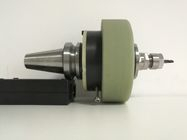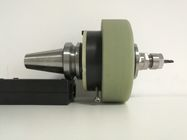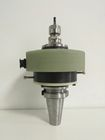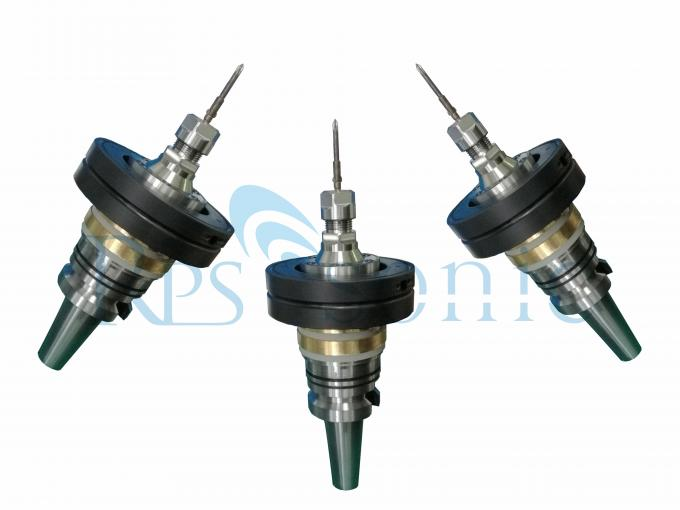
loading




| Place of Origin | CHINA |
|---|---|
| Brand Name | RPS-SONIC |
| Certification | CE |
| Model Number | RPS-M20 |
| Minimum Order Quantity | 1SET |
| Price | negotiation |
| Packaging Details | FOAM AND CARTON |
| Delivery Time | 3DAYS |
| Payment Terms | T/T, Western Union, MoneyGram, PAYPAL |
| Supply Ability | 500 SETS PER MONTH |
| Name | Ultrasonic Milling | Frequency | 20Khz |
|---|---|---|---|
| Power | 2000w | Type | Pencil Type, Metal Housing |
| Amplitude | 1~5um | Dameter | 120mm |
| High Light | ultrasonic machining products,ultrasonic drilling machine | ||
Take your machining capabilities to the next level, along with your bottom line, with ultrasonic milling: the latest in ultrasonic machining technology. Experience unprecedented machining efficiency with high performance ultrasonic milling, grinding, core drilling and light weighting of optical glasses and ceramics. Ultrasonic oscillation of the tool promotes free cutting of material, greatly reducing the force applied to the tool as well as the work piece during processing. This reduction in force allows for rapid material removal and faster cycle times as well as reduced tool wear and longer tool life.
Ultrasonic machining, or strictly speaking the "Ultrasonic vibration machining", is a subtraction manufacturing process that removes material from the surface of a part through high frequency, low amplitude vibrations of a tool against the material surface in the presence of fine abrasive particles. The tool travels vertically or orthogonal to the surface of the part at amplitudes of 0.05 to 0.125 mm (0.002 to 0.005 in.). The fine abrasive grains are mixed with water to form a slurry that is distributed across the part and the tip of the tool. Typical grain sizes of the abrasive material range from 100 to 1000, where smaller grains (higher grain number) produce smoother surface finishes.
Ultrasonic vibration machining is typically used on brittle materials as well as materials with a high hardness due to the micro-cracking mechanics.
| ITEM | PARAMETER |
| Frequency | 20Khz |
| Power | 500W |
| Amplitude | 1-5um |
| Dameter | 120MM |
Rotary ultrasonic vibration machining
In rotary ultrasonic vibration machining , the vertically oscillating tool is able to revolve about the vertical center line of the tool. Instead of using an abrasive slurry to remove material, the surface of the tool is impregnated with diamonds that grind down the surface of the part. Rotary ultrasonic machines are specialized in machining advanced ceramics and alloys such as glass, quartz, structural ceramics, Ti-alloys, alumina, and silicon carbide. Rotary ultrasonic machines are used to produce deep holes with a high level of precision.[citation needed]
Rotary ultrasonic vibration machining is a relatively new manufacturing process that is still being extensively researched. Currently, researchers are trying to adapt this process to the micro level and to allow the machine to operate similar to a milling machine
Advantages
Ultrasonic vibration machining is a unique non-traditional manufacturing process because it can produce parts with high precision that are made of hard and brittle materials which are often difficult to machine.[1] Additionally, ultrasonic machining is capable of manufacturing fragile materials such as glass and non-conductive metals that can not be machined by alternative methods such as electrical discharge machining and electrochemical machining. Ultrasonic machining is able to produce high-tolerance parts because there is no distortion of the worked material. The absence of distortion is due to no heat generation from the sonotrode against the work piece and is beneficial because the physical properties of the part will remain uniform throughout. Furthermore, no burrs are created in the process, thus fewer operations are required to produce a finished part


| Name | Ultrasonic Milling | Frequency | 20Khz |
|---|---|---|---|
| Power | 2000w | Type | Pencil Type, Metal Housing |
| Amplitude | 1~5um | Dameter | 120mm |
| High Light | ultrasonic machining products,ultrasonic drilling machine | ||
Take your machining capabilities to the next level, along with your bottom line, with ultrasonic milling: the latest in ultrasonic machining technology. Experience unprecedented machining efficiency with high performance ultrasonic milling, grinding, core drilling and light weighting of optical glasses and ceramics. Ultrasonic oscillation of the tool promotes free cutting of material, greatly reducing the force applied to the tool as well as the work piece during processing. This reduction in force allows for rapid material removal and faster cycle times as well as reduced tool wear and longer tool life.
Ultrasonic machining, or strictly speaking the "Ultrasonic vibration machining", is a subtraction manufacturing process that removes material from the surface of a part through high frequency, low amplitude vibrations of a tool against the material surface in the presence of fine abrasive particles. The tool travels vertically or orthogonal to the surface of the part at amplitudes of 0.05 to 0.125 mm (0.002 to 0.005 in.). The fine abrasive grains are mixed with water to form a slurry that is distributed across the part and the tip of the tool. Typical grain sizes of the abrasive material range from 100 to 1000, where smaller grains (higher grain number) produce smoother surface finishes.
Ultrasonic vibration machining is typically used on brittle materials as well as materials with a high hardness due to the micro-cracking mechanics.
| ITEM | PARAMETER |
| Frequency | 20Khz |
| Power | 500W |
| Amplitude | 1-5um |
| Dameter | 120MM |
Rotary ultrasonic vibration machining
In rotary ultrasonic vibration machining , the vertically oscillating tool is able to revolve about the vertical center line of the tool. Instead of using an abrasive slurry to remove material, the surface of the tool is impregnated with diamonds that grind down the surface of the part. Rotary ultrasonic machines are specialized in machining advanced ceramics and alloys such as glass, quartz, structural ceramics, Ti-alloys, alumina, and silicon carbide. Rotary ultrasonic machines are used to produce deep holes with a high level of precision.[citation needed]
Rotary ultrasonic vibration machining is a relatively new manufacturing process that is still being extensively researched. Currently, researchers are trying to adapt this process to the micro level and to allow the machine to operate similar to a milling machine
Advantages
Ultrasonic vibration machining is a unique non-traditional manufacturing process because it can produce parts with high precision that are made of hard and brittle materials which are often difficult to machine.[1] Additionally, ultrasonic machining is capable of manufacturing fragile materials such as glass and non-conductive metals that can not be machined by alternative methods such as electrical discharge machining and electrochemical machining. Ultrasonic machining is able to produce high-tolerance parts because there is no distortion of the worked material. The absence of distortion is due to no heat generation from the sonotrode against the work piece and is beneficial because the physical properties of the part will remain uniform throughout. Furthermore, no burrs are created in the process, thus fewer operations are required to produce a finished part










Ultrasonic Welding Equipment Ultrasonic Welding Transducer Ultrasonic Welding Converter Ultrasonic Liquid Processor Ultrasonic Cutting Equipment Ultrasonic Spray Nozzles Ultrasonic Power Supply Ultrasonic Soldering Equipment Ultrasonic Welding Horn Ultrasonic Assisted Machining Ultrasonic Testing Equipment
content is empty!